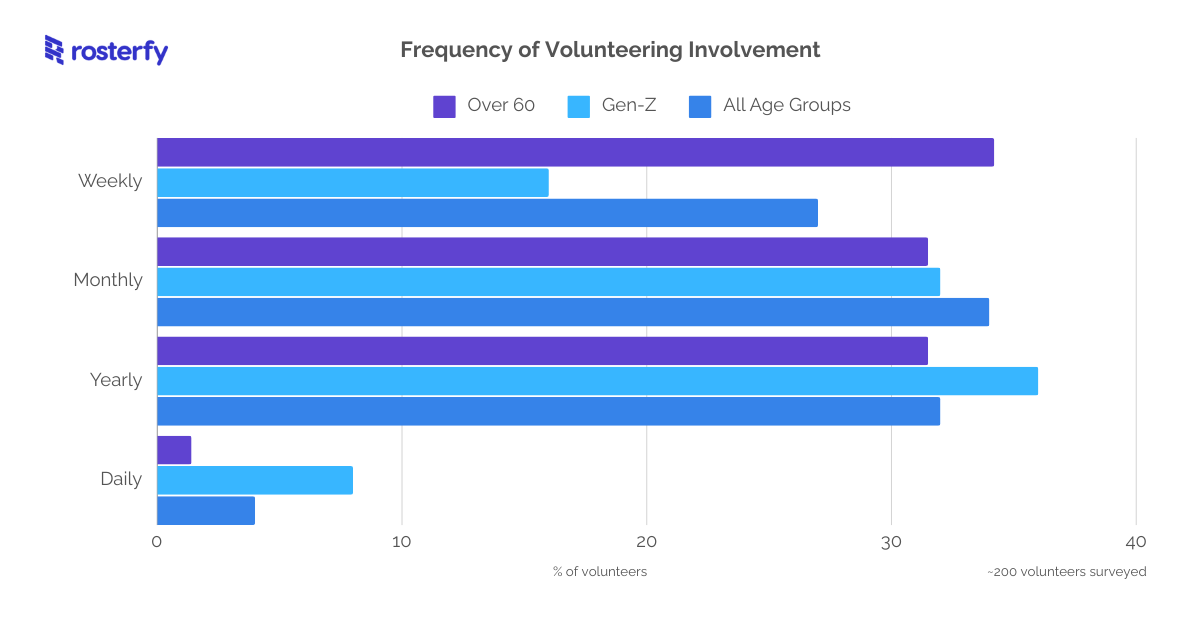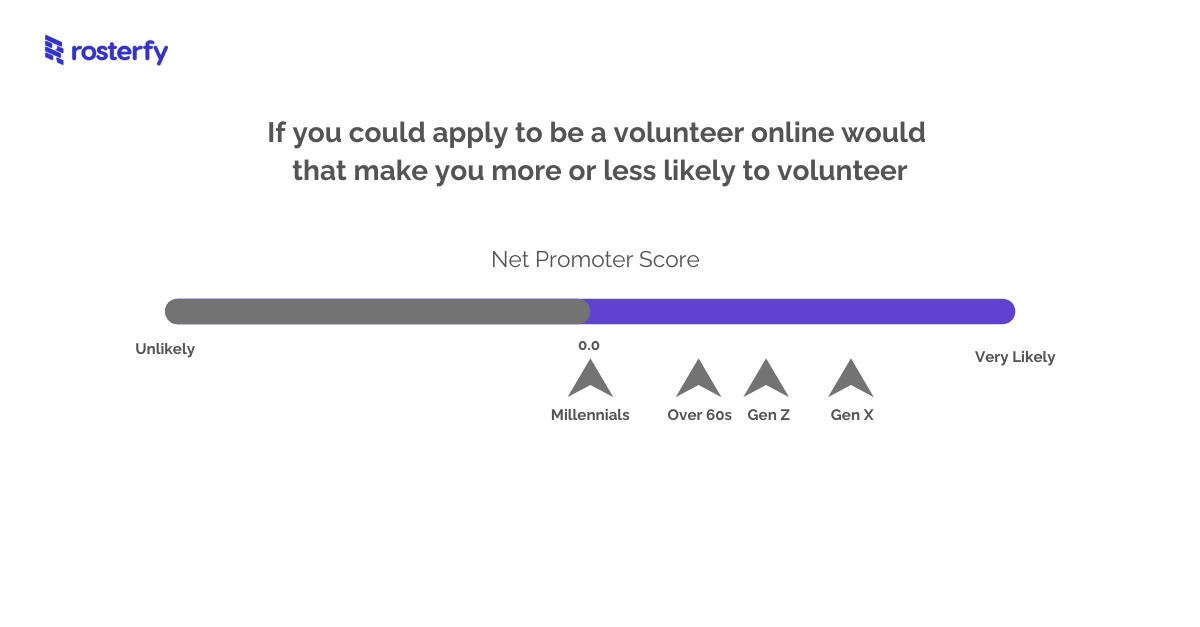How Does Volunteering Help The Community?
Discover the profound impact of volunteering, explore its benefits, and learn how to find the perfect opportunity.
A breakdown of our findings and what they reveal about the motivations and preferences of volunteers across different demographics.
Volunteering isn't just about lending a hand; it's a profound expression of community engagement and personal fulfillment. Understanding what motivates individuals to volunteer can significantly impact the effectiveness of volunteer programs.
Millions of people engage in volunteer activities through Rosterfy, making it crucial to understand their motivations and preferences to enhance volunteer program engagement. To achieve this, we surveyed a couple of hundred individuals within the Rosterfy community, aiming to gain insights that would aid in building more engaging volunteer programs.
Let's delve into the findings of this survey to better comprehend the driving forces behind volunteerism and how organizations can leverage this understanding to create impactful volunteer experiences.
The age distribution within our surveyed community provides valuable insights into the generational trends in volunteering:
Diverse Generational Participation: The survey revealed a diverse representation across age groups within the Rosterfy community, indicating that volunteerism transcends generational boundaries.
Strong Engagement from Older Adults: With 43.7% of respondents being over 60, it's evident that older adults are actively involved in volunteer activities, highlighting their commitment to community service and social impact.
Gen X and Millennials' Presence: While older adults constitute a significant portion, the survey also captured the participation of Gen X (24.1%) and Millennials (16.1%), showcasing a multi-generational interest in volunteerism.
Emerging Interest from Gen Z: The survey also noted a notable presence of Gen Z participants, comprising 14.4% of respondents. This suggests an emerging trend of younger individuals engaging in volunteer activities, underscoring their desire to contribute to societal well-being from an early age.
Inclusive Volunteer Opportunities: Considering the diverse age distribution, organizations should tailor volunteer programs to cater to the varying interests and preferences of different age groups, ensuring inclusivity and engagement across the board.
Understanding how often individuals volunteer sheds light on their commitment to community service:
These results varied when broken down by age demographic:

Consistent Engagement Across Generations: Despite varying preferences in volunteering frequency, each generational cohort demonstrates a commitment to community service, with distinct patterns emerging among different age groups.
Over 60s: Balanced Commitment: Older adults exhibit a balanced approach to volunteering, with weekly, yearly, and monthly commitments almost evenly distributed. This suggests a flexible and sustained involvement in volunteer activities among this demographic.
Gen X: Monthly Consistency: Monthly volunteering emerges as the preferred frequency among Gen X, indicating a desire for regular but less frequent engagement in community service. This generation values consistent contributions to causes they support.
Millennials: Periodic Engagement: Millennials prioritize yearly volunteering, possibly due to career and personal commitments. While they engage less frequently than Gen X, their commitment to annual volunteering underscores a desire to make impactful contributions at specific intervals.
Gen Z: Yearly Preference: Similar to Millennials, Gen Z favors yearly volunteering, possibly reflecting their transitional life stage and focus on education or early career development. However, a notable proportion also engages in monthly volunteering, indicating a willingness to contribute periodically despite other obligations. If you can target your volunteer program toward Gen Z's preferences, this is a huge opportunity to take advantage of this growing demographic.
Uncovering the driving factors behind volunteering behaviors helps organizations tailor their programs effectively. Here's what our survey revealed:
.png?width=1200&height=627&name=Motivate%20to%20Volunteer%20(3).png)
While certain motivations remained consistent across all age groups, there were notable differences in priorities:
Community Engagement and Social Connections: Across all age groups, the desire to be part of a community or to meet new people through volunteering emerged as a consistent and significant motivator. This highlights the importance of fostering social connections and a sense of belonging in volunteer initiatives.
Next steps: Implement programs and events aimed at fostering stronger bonds within your volunteer community. This could include regular meetups, social gatherings, or team-building activities to encourage interaction and camaraderie among volunteers.
Role of Recommendations: Personal recommendations from friends, family, or peers play a pivotal role in motivating individuals to volunteer. Word-of-mouth referrals serve as powerful endorsements, influencing volunteer decisions across generations.
Next steps: Make sure your volunteer program is one that people will recommend to their friends, family, and colleagues. If you're curious how to do that, we've written an entire article about it.
Emphasis on Online Accessibility: The availability of user-friendly online platforms or apps for accessing volunteering opportunities is crucial for engaging volunteers, particularly among older adults and Gen X. This underscores the importance of leveraging technology to facilitate volunteer engagement and streamline the volunteer recruitment process.
Next steps: Conduct a thorough assessment of the usability and effectiveness of current online platforms or apps used for volunteer engagement. Identify any pain points or areas for improvement to enhance the user experience. If you need help building a program that will suit your volunteers' needs, Rosterfy is here to help.
Over 60s: Emphasis on Community and Recommendations: Older adults prioritize community engagement above all else, underscoring their desire for meaningful social interactions and shared experiences. Personal recommendations also hold significant sway, indicating the importance of interpersonal relationships in influencing volunteer decisions among this demographic.
Next steps: To engage volunteers over 60, make sure you implement community-building programs, as mentioned earlier. Additionally, regularly solicit feedback from volunteers regarding their experiences. Use this input to refine and enhance your program, ensuring it's one that volunteers will want to recommend to others.
Gen X: Balancing Community and Technology: Gen X values community engagement similarly to older adults but also places a strong emphasis on online accessibility. This generation, while appreciating traditional community connections, is also comfortable with technology and values the convenience of accessing volunteer opportunities online.
Next steps: Recognize the preferences of Gen X volunteers by offering a variety of communication channels. Provide options for modern digital channels like email, social media, and messaging apps.
Millennials: Career-Oriented Motivations: Millennials prioritize career benefits alongside personal recommendations, indicating a desire for both personal and professional development opportunities through volunteering. This generation sees volunteering as a means to enhance their skills, expand their network, and bolster their career prospects.
Next steps: Develop volunteer roles that provide Millennials with opportunities to develop and enhance transferable skills relevant to their career aspirations. Offer training sessions, workshops, or projects that focus on skill development in areas such as leadership, communication, project management, and digital literacy.
Gen Z: Career-Focused with a Community Aspect: Career benefits take precedence for Gen Z, reflecting their pragmatic approach to volunteering and their focus on future success. However, community engagement remains important, suggesting that while career advancement is a priority, they also seek meaningful connections and experiences in their volunteer endeavors.
Next steps: Recognize and reward the contributions of Gen Z volunteers, acknowledging their dedication and commitment to both their careers and their communities. Provide incentives such as certificates, awards, or letters of recommendation that highlight their achievements and contributions.
The convenience of online applications significantly influences volunteering decisions:

Preference for Online Application: The majority of volunteers across different demographics show a positive inclination towards applying to volunteer entirely online. This preference underscores the convenience and accessibility offered by digital platforms in streamlining the volunteer application process.
Importance of Online Accessibility: Organizations should prioritize online accessibility and user experience when designing volunteer application processes. Streamlining online applications can attract a broader range of volunteers and enhance overall volunteer engagement.
Consider Millennials' Preferences: While Millennials may not strongly prefer online applications, organizations should still offer online options alongside traditional application methods to cater to diverse preferences and ensure inclusivity in volunteer recruitment efforts.
Understanding the types of volunteer work individuals are interested in helps organizations tailor their offerings:
.png?width=680&height=355&name=Frequency%20of%20Volunteering%20(2).png)
Preference for Event-Based Volunteering: Supporting mass events like marathons and sporting events emerges as the most popular type of volunteer work among respondents, indicating a strong interest in participating in large-scale community activities and fundraisers.
Environmental Consciousness: Eco-volunteering garners significant interest, reflecting a growing awareness and concern for environmental issues among volunteers. Organizations focusing on environmental conservation and sustainability initiatives can leverage this interest to attract and engage volunteers.
Focus on Social Impact: Volunteer roles involving working with families or care work, as well as cancer or healthcare fundraising, highlight a strong desire among respondents to contribute to causes that directly impact individuals' lives and well-being.
Mental Health Support: Mental health support or fundraising initiatives also garner notable interest, indicating a recognition of the importance of mental health advocacy and support within volunteer communities.
Opportunities for Skill-Based Volunteering: Roles such as working in a charity retail store or working with animals, while less popular overall, still attract a significant percentage of respondents. These opportunities may provide valuable skill-building experiences and allow volunteers to contribute in diverse ways based on their interests and abilities.
Diverse Offerings for Volunteer Engagement: Organizations should consider offering a diverse range of volunteer opportunities to cater to the varied interests and passions of volunteers. By providing options across different sectors and causes, organizations can effectively engage volunteers and maximize their impact in the community.
A significant proportion of respondents have engaged in volunteering through their employers:
.png?width=1200&height=627&name=Frequency%20of%20Volunteering%20(3).png)
Employer-Driven Volunteering is Common: A notable percentage of respondents report engaging in volunteering through their employers, indicating a widespread practice of employer-driven volunteer programs within the surveyed community.
Potential for Increased Participation: While a significant proportion of respondents have participated in employer-driven volunteering, there is still room for growth, as a majority of respondents have not yet engaged in such initiatives. This suggests an opportunity for organizations to further promote and encourage participation in employer-supported volunteer activities.
Our survey sheds light on the diverse motivations and preferences driving individuals to volunteer. From fostering community connections to seeking career benefits, volunteers' motivations are multifaceted and vary across different age groups. By understanding these nuances, organizations can better design volunteer programs that resonate with their audience, ultimately fostering a more engaged and committed volunteer base.
Rosterfy is used by nonprofits, charities, sporting federations, local governments, and more to better manage their volunteer programs by improving how they can recruit, screen, train, and retain volunteers.
Our market leading technology helps you create an engaging experience throughout the whole lifecycle of your volunteer journey.
Book a call today.
Discover the profound impact of volunteering, explore its benefits, and learn how to find the perfect opportunity.
When managing volunteers, the process of getting them onboarded is crucial for your organization’s success.
Group volunteering is not just a trend but a seismic shift in the way we approach community service.
Join thousands of volunteer managers who receive regular updates on practical insights, research-driven white papers, industry trends, case studies, and Rosterfy feature releases - all designed to make managing volunteers easier.